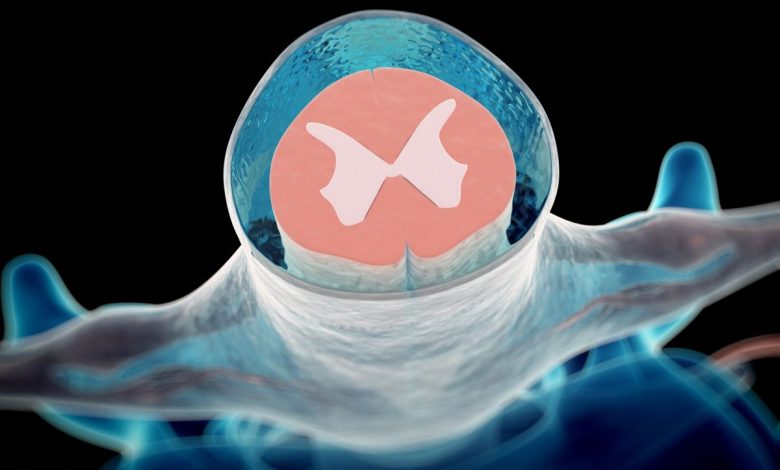Physical properties of cerebrospinal fluid in normal and pathological conditions

Number of cerebrospinal fluid
In adults, an average of 140-150 ml of cerebrospinal fluid, and in the subarachnoid space of the spinal cord is 50-60 ml, and in the subarachnoid space of the brain and the ventricles of the brain - 50-70 ml. Each lateral ventricle contains on average 10-15 ml of liquid, III and IV ventricle and cerebral aqueduct together - 5 ml.
According to reports, about 33 % cerebrospinal fluid in the ventricles of the brain accounts, 20 % taken in the subarachnoid space of the brain and 47 % - In the same space of the spinal cord. In infants, the amount varies from the cerebrospinal fluid 40 to 60 ml, and at the age of 1-15 years - from 60 to 120 ml.
Taking an adult 10 - 12 ml of cerebrospinal fluid is not accompanied by pathological reaction, since the volume of the spinal fluid is quickly restored.
Normally, the horizontal position of the body the cerebrospinal fluid flows under pressure 13,3 26,7 kPa (135,7-271.4 Cm of water. Art.). When purulent meningitis, gidrocefalii, brain tumors with occlusion spaces. which circulates the cerebrospinal fluid, as well as violation of its outflow or overproduction of cerebrospinal fluid pressure may increase significantly. After cranial trauma with impaired integrity of cerebrospinal fluid spaces, and the loss of her spinal fluid pressure is reduced.
The relative density of the cerebrospinal fluid
Cerebrospinal fluid, obtained by lumbar puncture, It has a relative density of 1,006-1,007; fluid, located in the ventricles,— 1,002-1.004. The reduction of the relative density is observed in the overproduction of cerebrospinal fluid, gidrocefalii. In inflammatory processes within the central nervous system, the relative density of the cerebrospinal fluid is increased to 1,012-1,015.
The reaction of the cerebrospinal fluid
The reaction is slightly alkaline fluid: 7,35-7.4. Determine the pH should be immediately after a spinal fluid under the paraffin oil, because the carbon dioxide air rapidly lowers the alkalinity.
Color cerebrospinal fluid
Normally, the cerebrospinal fluid is colorless. For determining the color of the cerebrospinal fluid compared with distilled water in colorless vials of the same diameter. At pathological conditions the liquid can be colored.
Ksantoxromija - Color of the cerebrospinal fluid in yellow - can be congestive and haemorrhagic.
Congestive xanthosis observed deceleration of blood flow in vessels of the brain and is often accompanied by an increase in protein content.
Hemorrhagic xanthosis occurs when red blood cells enter the cerebrospinal fluid, hemoglobin, which is converted to bilirubin and causes a yellow coloration. The conversion of hemoglobin into the spinal fluid bilirubin is carried out with the participation of enzymes endothelial system meninges. Hemorrhagic xanthosis usually expressed less intense, than congestive, when you stop the bleeding gradually decreases, disappearing in 10-14 days, and is not accompanied by significant proteinorrhachia (the release of the protein from cerebrospinal fluid).
Greenish-yellow color of cerebrospinal fluid purulent meningitis, abscess breakthrough in the subarachnoid space or ventricles of the brain due to the large number of white blood cells.
Grayish or grayish-pink color of cerebrospinal fluid It can be observed in the presence of a small amount of her red blood cells (due to falling blood during puncture or bleeding in the subarachnoid space).
Before the study of cerebrospinal fluid mixed with blood it is centrifuged. Discoloration in the liquid by centrifugation indicates blood entering the puncture in fresh or subarachnoid hemorrhage space. In the first hours after the hemorrhage may be missing xanthosis. It is observed in those cases, When red blood cells pass through the arachnoid into the subarachnoid space and into the blood. When brain tumors are not always detected xanthosis. Most often it is observed in malignant tumors, located near the subarachnoid space - melanoma, angiosarkome, glioblastoma multiforme.
Newborns, most preterm, found physiological xanthosis, due to increased permeability to bilirubin of the blood-brain barrier.
The yellow color of the cerebrospinal fluid It may also be due to the presence in it lipochromes (extremely rare) and drugs, such as penicillin. To determine the cause of the reaction xanthosis used for bilirubin with diazoreaktivom Ehrlich, benzidine or amidopirinovaya occult blood tests or determination of the presence of penicillin micromethod.
Transparency of the cerebrospinal fluid
Transparency of the cerebrospinal fluid is determined by comparing it with distilled water. In healthy people, the liquid is clear. Clouding it it is observed in pathological states and can be caused by the presence of erythrocytes, leukocyte or a large number of microorganisms. Turbidity, due to the presence of blood cells, disappears after centrifugation, and associated with the presence of microorganisms - is.
For the cerebrospinal fluid, containing a very large amount of coarse protein, characterized by slight opalescence, upon standing the liquid takes the form of gelatinous clot. It is rolling into a pouch only its outer layer. The film is placed on the slide, magenta tint, covered with a cover glass and observed under microscope. Typically, in the film and in the cerebrospinal fluid, enclosed in a sac of fibrin, are almost all times in cells.
Fibrinous film
Fibrinous film can be formed in the cerebrospinal fluid, or immediately upon taking it upon standing for several hours (to 24 no). The appearance of the film is observed with meningitis (tuberkuleznom, serous and others.). When tuberculous meningitis were stained by Ziehl-Nelsenu possible to identify in the fibrinous film mycobacterium tuberculosis. Therefore, if suspected tuberculous meningitis film is not formed soon, a test tube with cerebrospinal fluid is left for a day in a cold place or at room temperature.
